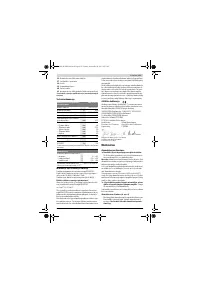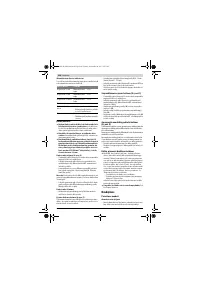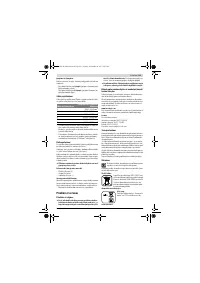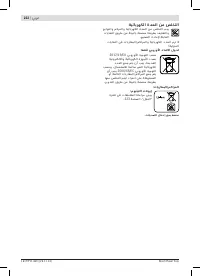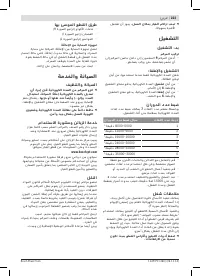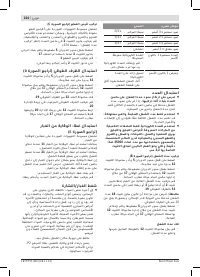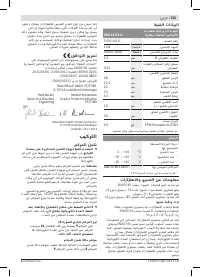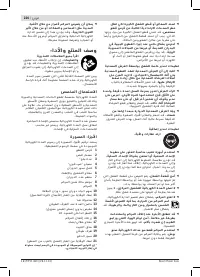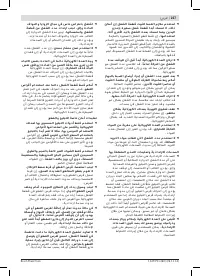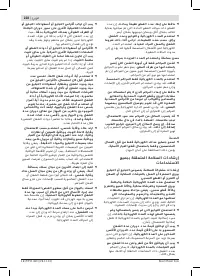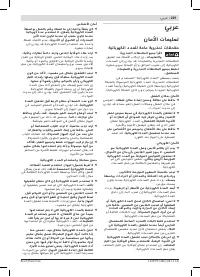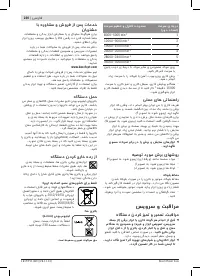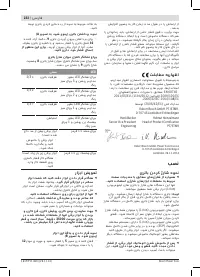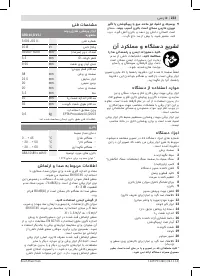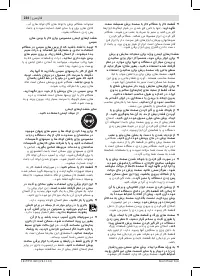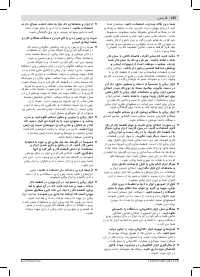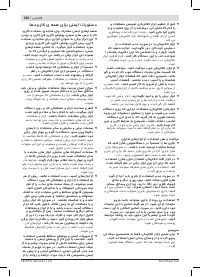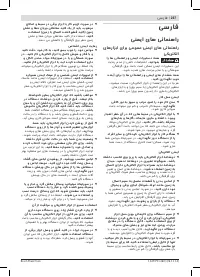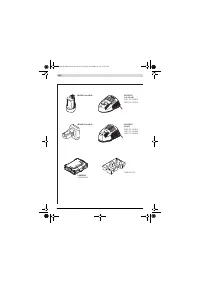Гравировальные машинки Bosch 0.601.9C5.000 - инструкция пользователя по применению, эксплуатации и установке на русском языке. Мы надеемся, она поможет вам решить возникшие у вас вопросы при эксплуатации техники.
Если остались вопросы, задайте их в комментариях после инструкции.
"Загружаем инструкцию", означает, что нужно подождать пока файл загрузится и можно будет его читать онлайн. Некоторые инструкции очень большие и время их появления зависит от вашей скорости интернета.
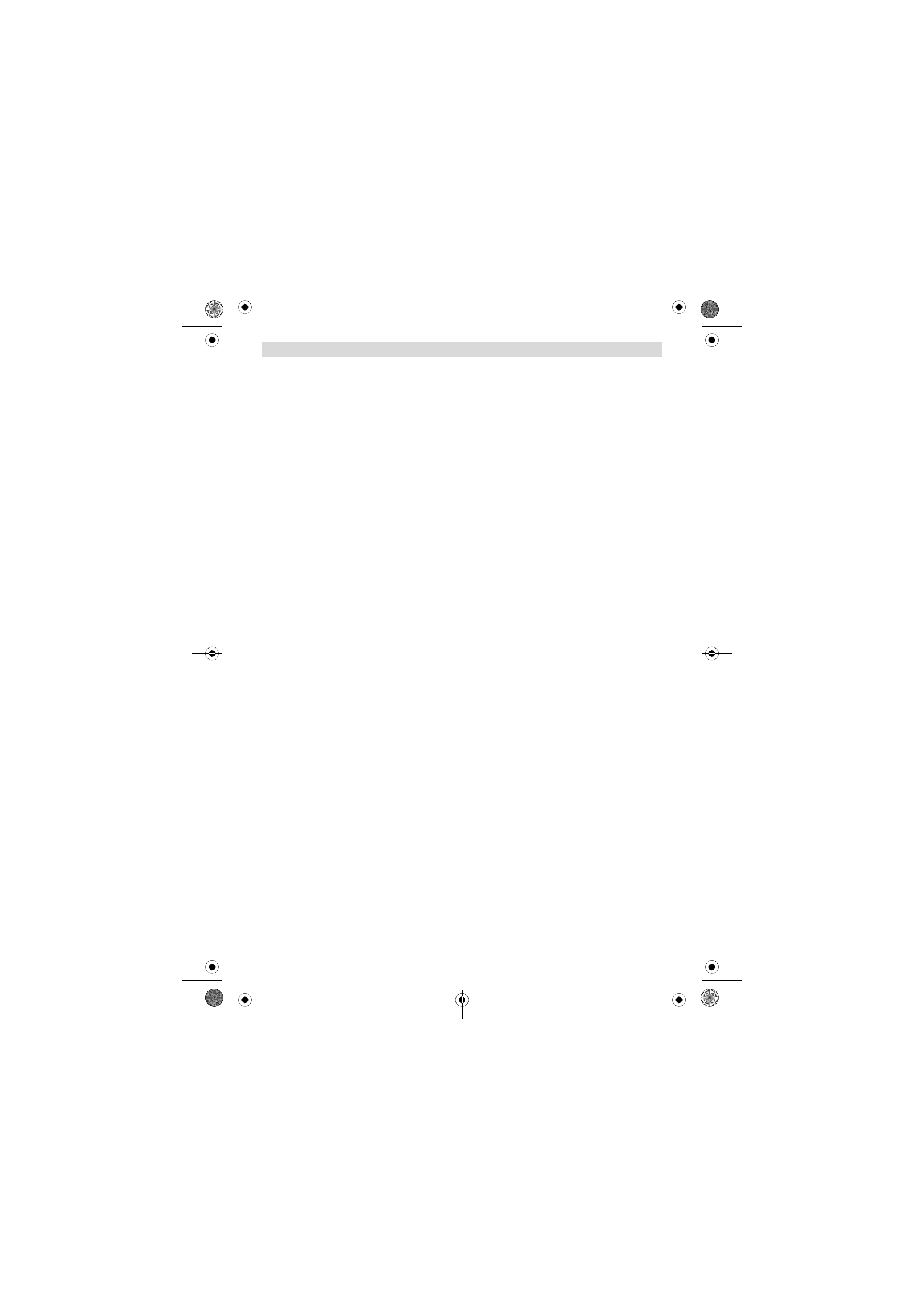
English |
15
Bosch Power Tools
1 619 P11 460 | (26.11.13)
The outside diameter and the thickness of your acces-
sory must be within the capacity rating of your power
tool.
Incorrectly sized accessories cannot be adequately
guarded or controlled.
The arbour size of wheels, sanding drums or any other
accessory must properly fit the spindle or collet of the
power tool.
Accessories that do not match the mounting
hardware of the power tool will run out of balance, vibrate
excessively and may cause loss of control.
Mandrel mounted wheels, sanding drums, cutters or
other accessories must be fully inserted into the collet
or chuck.
If the mandrel is insufficiently held and/or the
overhang of the wheel is too long, the mounted wheel may
become loose and ejected at high velocity.
Do not use a damaged accessory. Before each use in-
spect the accessory such as abrasive wheels for chips
and cracks, sanding drum for cracks, tear or excess
wear, wire brush for loose or cracked wires. If power
tool or accessory is dropped, inspect for damage or in-
stall an undamaged accessory. After inspecting and in-
stalling an accessory, position yourself and bystanders
away from the plane of the rotating accessory and run
the power tool at maximum no-load speed for one min-
ute.
Damaged accessories will normally break apart during
this test time.
Wear personal protective equipment. Depending on
application, use face shield, safety goggles or safety
glasses. As appropriate, wear dust mask, hearing pro-
tectors, gloves and shop apron capable of stopping
small abrasive or workpiece fragments.
The eye protec-
tion must be capable of stopping flying debris generated
by various operations. The dust mask or respirator must be
capable of filtrating particles generated by your operation.
Prolonged exposure to high intensity noise may cause
hearing loss.
Keep bystanders a safe distance away from work area.
Anyone entering the work area must wear personal
protective equipment.
Fragments of workpiece or of a
broken accessory may fly away and cause injury beyond
immediate area of operation.
Hold power tool by insulated gripping surfaces only,
when performing an operation where the cutting ac-
cessory may contact hidden wiring.
Cutting accessory
contacting a “live” wire may make exposed metal parts of
the power tool “live” and shock the operator.
Always hold the tool firmly in your hand(s) during the
start-up.
The reaction torque of the motor, as it acceler-
ates to full speed, can cause the tool to twist.
Use clamps to support workpiece whenever practical.
Never hold a small workpiece in one hand and the tool
in the other hand while in use.
Clamping a small work-
piece allows you to use both hands to control the tool.
Round material such as dowel rods, pipes or tubing have a
tendency to roll while being cut, and may cause the bit to
bind or jump toward you.
Never lay the power tool down until the accessory has
come to a complete stop.
The spinning wheel may grab
the surface and pull the power tool out of your control.
After changing the bits or making any adjustments,
make sure the collet nut, chuck or any other adjust-
ment devices are securely tightened.
Loose adjustment
devices can unexpectedly shift, causing loss of control,
loose rotating components will be violently thrown.
Do not run the power tool while carrying it at your side.
Accidental contact with the spinning accessory could snag
your clothing, pulling the accessory into your body.
Regularly clean the power tool’s air vents.
The motor’s fan
will draw the dust inside the housing and excessive accumu-
lation of powdered metal may cause electrical hazards.
Do not operate the power tool near flammable materi-
als.
Sparks could ignite these materials.
Do not use accessories that require liquid coolants.
Us-
ing water or other liquid coolants may result in electrocu-
tion or shock.
Kickback and related warnings
Kickback is a sudden reaction to a pinched or snagged rotat-
ing wheel, backing pad, brush or any other accessory.
Pinching or snagging causes rapid stalling of the rotating ac-
cessory which in turn causes the uncontrolled power tool to
be forced in the direction opposite of the accessory’s rota-
tion at the point of the binding.
For example, if an abrasive wheel is snagged or pinched by
the workpiece, the edge of the wheel that is entering into the
pinch point can dig into the surface of the material causing
the wheel to climb out or kick out. The wheel may either
jump toward or away from the operator, depending on di-
rection of the wheel’s movement at the point of pinching.
Abrasive wheels may also break under these conditions.
Kickback is the result of power tool misuse and/or incorrect
operating procedures or conditions and can be avoided by
taking proper precautions as given below.
Maintain a firm grip on the power tool and position your
body and arm to allow you to resist kickback forces.
The operator can control kickback forces, if proper precau-
tions are taken.
Use special care when working corners, sharp edges,
etc. Avoid bouncing and snagging the accessory.
Cor-
ners, sharp edges or bouncing have a tendency to snag the
rotating accessory and cause loss of control or kickback.
Do not use a toothed saw blade.
Such blades create fre-
quent kickback and loss of control over the power tool.
Always feed the bit into the material in the same direc-
tion as the cutting edge is exiting from the material
(which is the same direction as the chips are thrown).
Feeding the tool in the wrong direction causes the cutting
edge of the bit to climb out of the work and pull the tool in
the direction of this feed.
When using rotary files, cut-off wheels, high-speed cut-
ters or tungsten carbide cutters, always have the work
securely clamped.
These wheels will grab if they become
slightly canted in the groove, and can kickback. When a
cut-off wheel grabs, the wheel itself usually breaks. When
the rotary file, high-speed cutter or tungsten carbide cut-
ter grab, it may jump from the groove and you could lose
control of the tool.
OBJ_BUCH-2020-001.book Page 15 Tuesday, November 26, 2013 2:57 PM
Содержание
- 132 Безопасность рабочего места
- 133 Сервис
- 134 Не используйте пильные диски с зубьями.
- 135 Дополнительные предупредительные указания
- 136 Описание продукта и услуг; Применение по назначению; Пользуйтесь средствами защиты органов слуха!
- 137 Заявление о соответствии; Сборка; Зарядка аккумулятора; не прилагая чрезмерного усилия; Замена рабочего инструмента; , с наружным диаметром
- 138 Изъятие инструмента из патрона; Отсос пыли и стружки; Избегайте скопления пыли на рабочем месте.; Работа с инструментом; Включение электроинструмента; Установка аккумулятора; Установка числа оборотов; Диапазон настройки частоты
- 139 Указания по применению; Рекомендуемые методы отрезания; Техобслуживание и сервис; Техобслуживание и очистка; Россия; Транспортировка
- 140 Утилизация; Українська; Вказівки з техніки безпеки; Загальні застереження для електроприладів; Безпека на робочому місці
Характеристики
Остались вопросы?Не нашли свой ответ в руководстве или возникли другие проблемы? Задайте свой вопрос в форме ниже с подробным описанием вашей ситуации, чтобы другие люди и специалисты смогли дать на него ответ. Если вы знаете как решить проблему другого человека, пожалуйста, подскажите ему :)



























































































































































































































